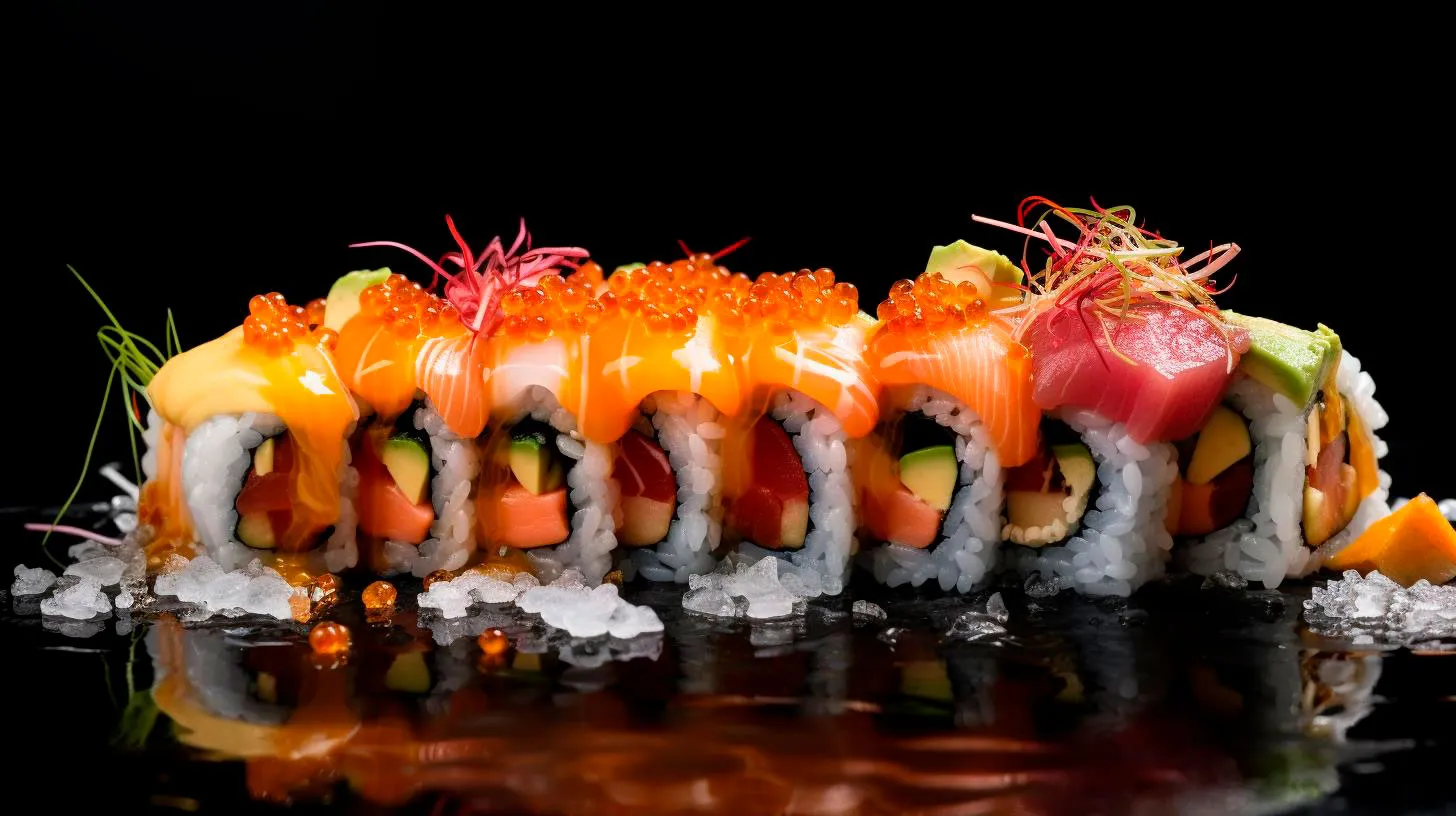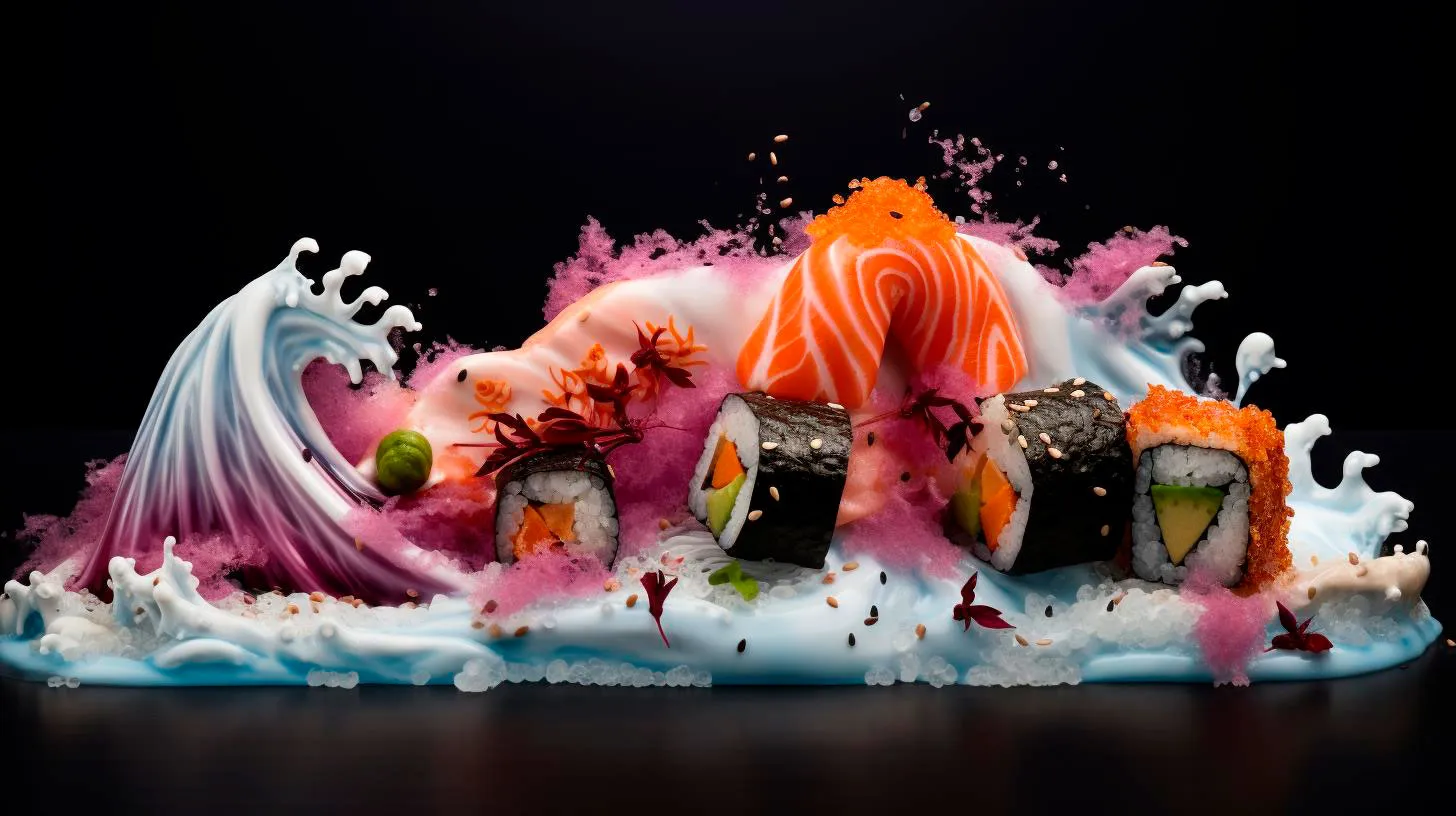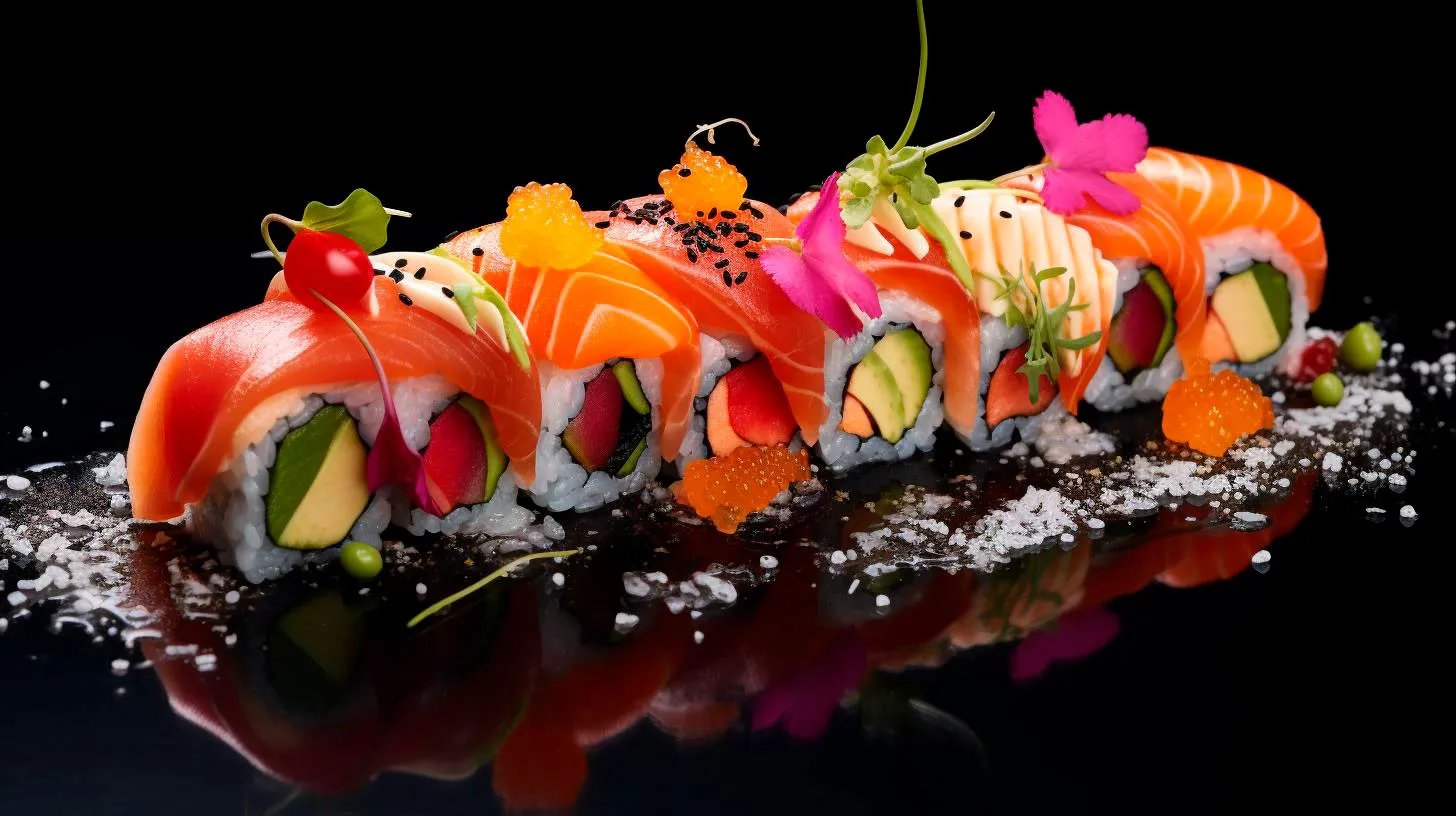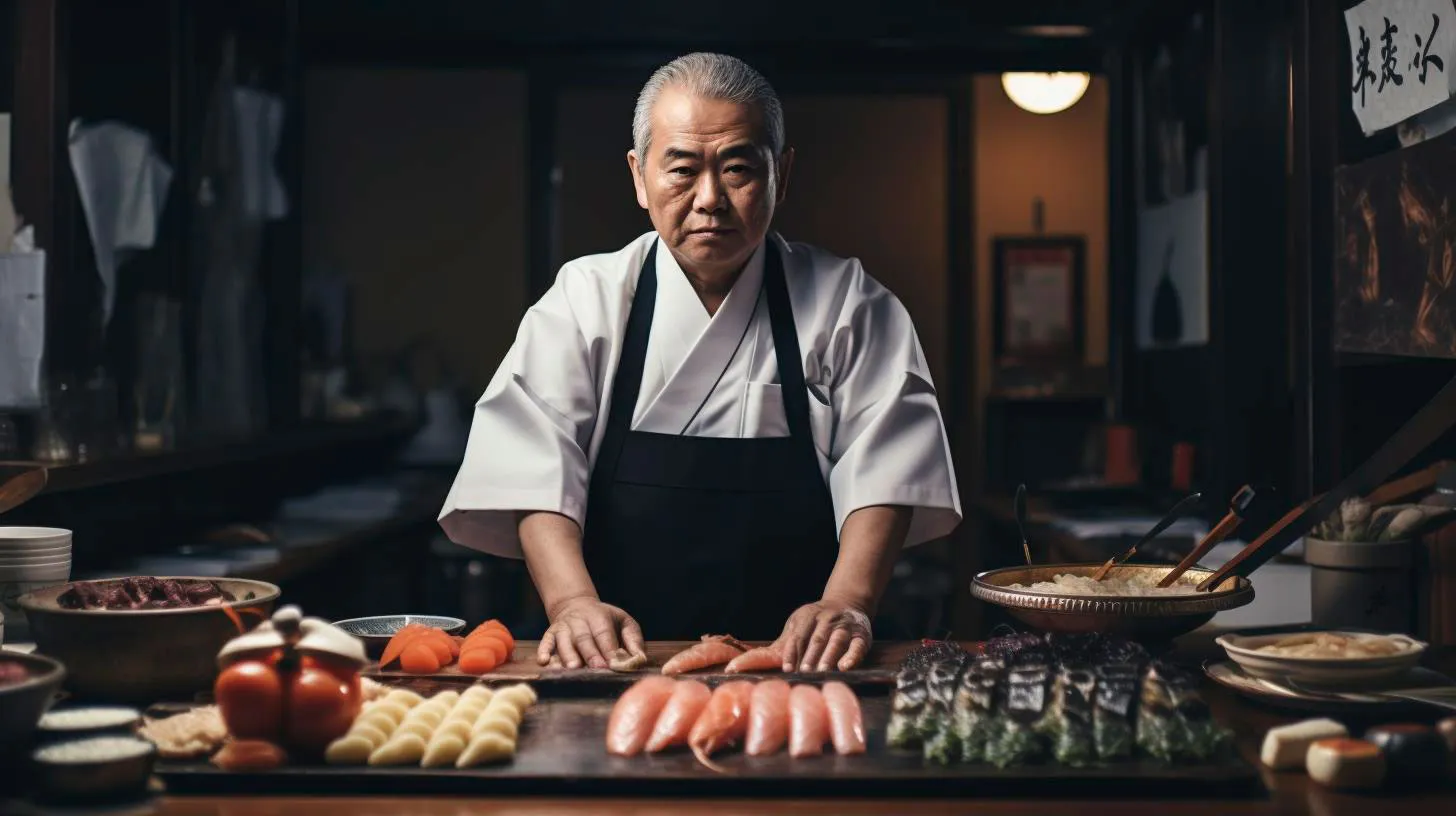Savoring Sushi: Discovering Local Sushi Customs in Japan
In this article, we will delve into the local customs and practices of savoring sushi in its birthplace, providing you with insights that will enrich your sushi experience.
Understanding the Art of Sushi Making
Sushi making is an ancient art form in Japan, dating back to the 12th century. It involves the careful selection of high-quality ingredients, masterful knife skills, and a keen eye for presentation. Traditional sushi chefs, known as itamae, undergo years of rigorous training to perfect their craft, ensuring that each piece of sushi is a culinary masterpiece.
Key Takeaway: The art of sushi making requires skill, precision, and a deep understanding of Japanese culinary traditions.
The Omakase Experience
One of the best ways to truly savor sushi in Japan is through the omakase experience. Omakase, meaning “I’ll leave it up to you” in Japanese, is a dining concept where the chef personally selects and prepares a series of sushi dishes for you. This allows the chef to showcase their expertise and creativity while tailoring the menu to your individual preferences.
During an omakase meal, you will sit at the counter, right in front of the sushi chef, creating an intimate dining experience. As each piece of sushi is served, the chef will often explain the ingredients and the best way to enjoy it. This personalized interaction adds an extra layer of appreciation to the dining experience, fostering a deeper connection between the chef and their guests.
Key Takeaway: The omakase experience offers a unique opportunity to discover the chef’s creativity and expertise, elevating your sushi experience to new heights.
Local Sushi Customs
When enjoying sushi in Japan, it is essential to be aware of the local customs and etiquette to fully immerse yourself in the experience. Here are some key practices to keep in mind:
- Respectful Greetings: Upon entering a traditional sushiya (sushi restaurant), it’s customary to greet the chef with a polite “irasshaimase” (welcome). This gesture shows respect and appreciation for their craft.
- Using Chopsticks and Fingers: While chopsticks are commonly used to eat sushi, it is also acceptable to eat nigiri sushi with your hands. However, it’s best to follow the lead of locals or the guidance of the chef.
- Wasabi Placement: In Japan, the chef typically adds wasabi between the fish and rice in nigiri sushi. Refrain from adding extra wasabi, as it might alter the intended balance of flavors.
- Appreciate Each Bite: Savor the sushi slowly and appreciate the intricate flavors. Avoid adding additional soy sauce or excessive wasabi, as it may overpower the taste the chef intended.
- Ending the Meal: Once you have finished your sushi feast, it is polite to express your gratitude to the chef by saying “gochisousama deshita,” which translates to “thank you for the delicious meal.”
Key Takeaway: Understanding and respecting local sushi customs will enhance your dining experience and show appreciation for Japanese culture.
Regional Sushi Varieties
Japan is known for its regional diversity, and sushi is no exception. Various regions across the country have their own unique styles and specialties when it comes to sushi. Here are a few notable varieties:
- Edomae Sushi: Originating in Tokyo, Edomae sushi focuses on simplicity and elegance. It features lightly seasoned fish and vinegared rice, allowing the natural flavors to shine.
- Kansai Sushi: Commonly found in Osaka and Kyoto, Kansai sushi often includes a variety of ingredients such as cooked fish, pickled vegetables, and even fried items. It offers a delightful fusion of flavors and textures.
- Hakodate Sushi: Hailing from the northern city of Hakodate, this style of sushi is characterized by its usage of marinated seafood and sweet soy sauce. It provides a distinct and tantalizing taste.
Key Takeaway: Exploring regional sushi varieties allows you to discover the diverse flavors and techniques that exist within Japan’s culinary landscape.
Preserving Sushi Culture
Although the world has embraced sushi in various forms, it is essential to honor and preserve its traditional cultural roots. By seeking authentic sushi experiences and respecting the customs associated with it, we contribute to the preservation of this timeless and revered culinary art form.
Whether you’re a sushi connoisseur or a curious food lover, savoring sushi in Japan goes beyond mere consumption. It is a journey that immerses you in the rich history, meticulous techniques, and distinctive customs that surround this beloved cuisine. So, the next time you enjoy sushi, take a moment to appreciate its origins and the cultural significance it holds.
Key Takeaway: Respecting sushi traditions helps maintain the cultural heritage behind this cherished Japanese culinary art.
Embracing the customs, appreciating the craft, and exploring the diverse offerings within Japan’s sushi culture will undoubtedly enhance your dining experiences. So, the next time you find yourself in Japan, don’t miss the opportunity to indulge in an authentic sushi adventure.
Sushi Seasonality Dive into the Regional Delicacies
However, there is much more to sushi than meets the eye. One aspect that often goes unnoticed is the seasonality of ingredients and the regional delicacies that enhance the overall experience. Join us on a journey as we dive into the world of sushi seasonality and explore the unique flavors each region has to offer.
Understanding Seasonality in Sushi
The concept of seasonality is deeply rooted in traditional Japanese cuisine, and sushi is no exception. Sushi chefs take pride in using the freshest, seasonal ingredients to create harmonious and flavorful combinations. In Japan, for example, spring brings forth cherry blossoms and an abundance of ingredients like bamboo shoots, sweet shrimp, and firefly squid, all of which find their way onto sushi plates during this time. As the seasons change, so do the offerings, allowing sushi aficionados to experience a diverse array of tastes that mirror the shifting landscapes outside.
Exploring Regional Delicacies
Japan is a country of diverse landscapes, each with its own local delicacies. The regional differences in sushi reflect the availability of ingredients and the unique preferences of the local population. Let’s explore some of the key regions known for their exceptional sushi:
1. Tokyo
Tokyo, the sushi capital of Japan, is renowned for its dedication to perfection. Here, you will find the finest cuts of fish, delicately prepared with precision and an unwavering attention to detail. Tokyo sushi is known for its simplicity, allowing the quality of the ingredients to shine. Don’t miss the opportunity to savor the iconic Tokyo-style nigiri sushi, where a small piece of fish is draped over a mound of vinegared rice.
2. Hokkaido
Hokkaido, the northernmost island of Japan, boasts an abundance of fresh seafood thanks to its pristine waters. The region’s cold climate contributes to the unique delicacies found here. Hokkaido is famous for its uni (sea urchin), ikura (salmon roe), and hairy crab. The rich, creamy textures and briny flavors of these ingredients make Hokkaido sushi a truly memorable experience.
3. Osaka
In Osaka, a vibrant city known for its street food culture, you will find a different take on sushi. Here, the focus is on “oshizushi,” or pressed sushi. Oshizushi is made by pressing layers of rice and fish into a rectangular-shaped mold. The result is a visually stunning sushi with intricately patterned toppings that combine flavors and textures in surprising ways.
4. Kyushu
Kyushu, located in the southwestern part of Japan, is known for its bold and spicy flavors. This region embraces sushi varieties that incorporate local ingredients such as mentaiko (spicy cod roe), which adds a fiery kick. Kyushu sushi showcases the adventurous side of Japanese cuisine and is perfect for those who want to step out of their comfort zone.
The Advantages of Exploring Sushi Seasonality
By delving into the world of sushi seasonality and regional delicacies, you open yourself up to a whole new realm of flavors and experiences. Here are some key advantages:
- Enhanced freshness: Seasonal ingredients are at their peak freshness, ensuring an unforgettable dining experience.
- Connection to nature: Sushi seasonality allows us to connect with the changing seasons and appreciate the seasonal beauty nature offers.
- Expanded palate: Exploring regional delicacies exposes your palate to a wider range of flavors, textures, and ingredients.
- Authenticity: By embracing sushi seasonality, you are embracing the true essence of Japanese culinary tradition.
Key Takeaways
Sushi seasonality provides a fascinating dimension to the world of sushi, highlighting the importance of fresh ingredients and regional diversity. Remember these key takeaways:
- Traditional Japanese cuisine embraces the concept of seasonality.
- Each region in Japan offers unique sushi delicacies based on local ingredients and preferences.
- Exploring sushi seasonality enhances freshness, expands your palate, and connects you to nature.
So, the next time you sit down to enjoy a plate of sushi, take a moment to appreciate the regional flavors and the thoughtfulness that went into creating that extraordinary bite. Let sushi seasonality transport you to the diverse and delicious world of Japanese cuisine.
The Origins of Sushi in Japanese Culinary Traditions
The Birth of Sushi
The story of sushi begins in ancient Japan, around the 8th century AD during the Nara period. Originally, sushi was not the delectable combination of vinegared rice and fresh seafood that we know today. In fact, it was quite different.
During that time, raw fish was preserved by placing it between layers of cooked rice and salt. The purpose of this preservation method was to ferment and preserve the fish for a few months. This technique, known as narezushi, was a vital food source during long winters when fresh fish was scarce.
Over time, people discovered that the preserved fish had a unique taste, offering new flavors and textures. This led to the gradual development of a sushi-making method that focused on enhancing the taste and texture of both the fish and the rice.
The Evolution of Sushi
During the Muromachi period (1336-1573), a significant shift occurred in sushi preparation. Hanaya Yohei, a sushi chef from Edo (now Tokyo), revolutionized sushi by creating a new technique called nigiri sushi. This technique involved molding vinegared rice into bite-sized pieces, topped with fresh, raw fish.
This innovation transformed sushi into a delicate and visually appealing dish that could be enjoyed on the spot. The instant consumption of sushi allowed for a more nuanced experience of the flavors and textures, bringing it closer to the sushi we know and love today.
Following this breakthrough, sushi gained popularity not only as a preserved food but also as a culinary delight consumed in sushi stalls and restaurants across Japan. The Edo period (1603-1868) witnessed the rise of sushi as street food, making it accessible to people from all walks of life.
Sushi Goes Global
Fast forward to the 20th century when Japan’s rapid technological advancements and improved transportation systems made it possible for sushi to travel beyond its borders. Sushi began to capture the attention and taste buds of people around the world.
In the 1950s, sushi evolved once again with the creation of maki rolls. These rolls consisted of seafood, vegetables, or other ingredients wrapped in seaweed and rice. Maki rolls became wildly popular, becoming a staple in sushi restaurants globally.
Today, sushi is not only a symbol of Japanese culinary traditions but also a global phenomenon. Sushi restaurants can be found in every corner of the world, catering to people’s growing love for this artful cuisine.
Key Takeaways
- Sushi originated in ancient Japan, where it was used as a preservation technique for raw fish during long winters.
- Hanaya Yohei introduced nigiri sushi during the Muromachi period, transforming sushi into a visually appealing dish.
- The Edo period witnessed the rise of sushi as street food, making it accessible to the masses.
- Sushi’s popularity expanded globally in the 20th century, propelled by technological advancements and the creation of maki rolls.
Advantages of Sushi
Sushi offers numerous advantages that contribute to its enduring popularity:
- Healthy Choice: Sushi is often low in calories and rich in essential nutrients, making it a healthier alternative to many other fast food options.
- Artful Presentation: Sushi’s visually appealing presentation makes it a feast for the eyes as well as the palate.
- Diverse Options: Sushi caters to various dietary preferences with an array of vegetarian, seafood, and meat options.
- Quick and Convenient: Sushi is a convenient grab-and-go option for those on the move or looking for a quick meal.
In conclusion, sushi’s journey from a humble preservation method to a global culinary sensation is a testament to the impressive evolution of Japanese cuisine. Its rich history, artful presentation, and health benefits continue to captivate sushi lovers worldwide. So, the next time you savor a piece of sushi, remember the centuries of tradition and innovation behind this iconic dish.
Unique Flavors: Exquisite Sushi Varieties Across Japan
In this article, we will take you on a journey through some of these extraordinary flavors and highlight the diversity that makes Japan’s sushi scene truly exceptional.
Fusion Sushi: Where Tradition Meets Innovation
Japan has always been at the forefront of culinary innovation, and sushi is no exception. The fusion sushi trend combines traditional techniques with exciting ingredients from around the world, resulting in unforgettable flavor combinations. Some popular fusion sushi types include:
- Tempura Sushi: Crispy tempura batter adds a delightful crunch to the traditional sushi roll.
- Spicy Tuna Roll: A fiery twist on the classic tuna roll, often made with spicy mayonnaise and chili peppers.
- Rainbow Roll: A colorful creation that features various types of fish or seafood on top of a California roll.
One of the key advantages of fusion sushi is the ability to infuse local and foreign flavors, attracting a wider range of sushi enthusiasts. It’s a testament to Japan’s constant adaptation to international tastes while maintaining its sushi-making traditions.
Regionally Inspired Sushi: Celebrating Local Flavors
Japan’s diverse regions boast their unique local ingredients, and sushi is no exception. Each area’s distinct culinary heritage shines through in their sushi offerings. Let’s explore some of the regional sushi specialties:
- Hokkaido: Known for its pristine seafood, Hokkaido offers sushi featuring fresh scallops, king crabs, and sea urchins.
- Kyoto: With a focus on elegance, Kyoto’s sushi is characterized by delicate flavors, utilizing freshwater eel and mackerel.
- Kansai: Osaka’s love for street food translates into sushi with a twist, often incorporating local favorites like takoyaki or okonomiyaki.
By embracing local ingredients and culinary traditions, these regional sushi varieties provide a unique experience that reflects the local culture and gastronomy.
Vegetarian and Vegan Sushi: Delightful Plant-Based Options
As the world becomes more conscious about dietary preferences, vegetarian and vegan sushi options have gained popularity in recent years. With creative alternatives to fish, these plant-based sushi varieties are a treat for everyone. Some noteworthy options include:
- Avocado Roll: Creamy avocado takes center stage, adding a buttery texture to the sushi roll.
- Shiitake Mushroom Nigiri: Earthy and flavorful, shiitake mushrooms offer a wonderful umami taste.
- Inari Sushi: A sweet and tangy combination of sushi rice wrapped in seasoned tofu pouches.
Vegetarian and vegan sushi not only caters to specific dietary needs but also showcases the versatility of sushi as a culinary art form that can cater to a wider audience.
Key Takeaways
- Japan’s sushi scene goes beyond the traditional types, offering fusion sushi with innovative combinations.
- Regional sushi specialties highlight the unique flavors of each area, celebrating local ingredients.
- Vegetarian and vegan sushi varieties cater to a broader audience, showcasing the versatility of this culinary art form.
Japan’s sushi landscape is as diverse and exciting as the country itself. With fusion sushi, regional specialties, and plant-based options, there is something to satisfy every palate. Embark on a sushi adventure across Japan, and let your taste buds explore the extraordinary flavors offered by this beloved traditional dish.



